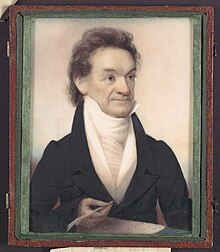Edward Livingston
[2] Livingston represented both New York and then Louisiana in Congress and served as the U.S. Secretary of State from 1831 to 1833[3] and Minister to France from 1833 to 1835 under President Andrew Jackson.
[11] Livingston was admitted to the bar in 1785, and began to practice law in New York City along with James Kent, Aaron Burr and Alexander Hamilton, rapidly rising to distinction.
[12] From 1795 to 1801, Livingston was a Democratic-Republican U.S. Representative in the United States Congress from the state of New York, where he was one of the leaders of the opposition to Jay's Treaty, and introduced the resolution calling upon President George Washington to furnish Congress with the details of the negotiations of the peace treaty with the Kingdom of Great Britain, which the President refused to share.
When, in the summer of 1803, the city was visited with yellow fever, Livingston displayed courage and energy in his endeavors to prevent the spread of the disease and relieve distress.
[14] Upon his recovery he found his private affairs in some confusion, and he was at the same time deeply indebted to the government for public funds which had been lost through the mismanagement or dishonesty of a confidential clerk, and for which he was responsible as US attorney.
[citation needed] Edward Livingston soon built a large law practice in New Orleans, and in 1826 he repaid the Federal government in full, including the interest, which by that time amounted to more than the original principal.
Great popular excitement was aroused against him; his workmen were mobbed; and territorial Governor William C. C. Claiborne, when appealed to for protection, referred the question to the Federal government.
During the War of 1812, Edward Livingston was active in rousing the ethnically mixed population of New Orleans to resistance against the threat of British invasion.
He used his influence to secure amnesty for Jean Lafitte and his followers when they offered to help defend the city, and in 1814–15 acted as adviser and one of several aides-de-camp to Major General Andrew Jackson, who was his personal friend.
It was prepared in both French and English, as was required by the necessities of practice in Louisiana, and actually consisted of four sections: crimes and punishments, procedure, evidence in criminal cases, and reform and prison discipline.
His Code of Reform and Prison Discipline was adopted by the government of the short-lived Federal Republic of Central America under liberal president Francisco Morazán.
She was a woman of extraordinary beauty and intellect: "the lady name is short, but she is said to be majestic in her person and elegant in manners with a long purse".
[15] Together, Louise and Edward were the parents of two children, only one of whom lived to adulthood:[11] Livingston died on May 23, 1836, five days before his 72nd birthday at Montgomery Place in Red Hook, New York, an estate left him by his sister, to which he had removed in 1831.
